“I can’t remember how I first came across the bunker,” says Kerry Guinan. We are in one of the guardhouses at Custume Barracks, in Athlone, waiting to explore Ireland’s “secret” government fallout shelter, and there’s a frisson of excitement in the assembled group. Who knew there was a nuclear bunker in the heart of Ireland? Imaginations, running on an Ernst Blofeld/Dr No kind of track, are shortly due to be pretty disappointed.
Instead, we are led through the large Army campus, past parade grounds with a view of the field where (some say) the duke of Wellington’s horse came to recover from stressful campaigning. Around the back, and past various bits of military apparatus, is what is still called the new block, although it was built in the 1960s. There, on the lower ground floor, and half-forgotten, is what we have come to see.
Once designated the national control centre, this was where Ireland’s systems of government and communications were to have been kept going in case of nuclear war reaching our shores. These days, some of the warren of low-ceilinged spaces are used as storage, some are locker rooms, and many are empty. Makeshift doors made of wood and wire are unlocked, and we can see the remnants of wiring, fuse-boxes and a broken bicycle. There is an eclectic selection of graffiti. “It’s more a basement than a bunker,” says Lieut Billy Henshaw, half-apologetically, as he suggests we explore.
Nuclear anxieties were peaking at the height of the cold war between the United States and the former Soviet Union, and countries not directly involved also feared the consequences of fallout. In 1962, Esquire magazine ran a front-page feature on the nine safest places on the planet to survive atomic war. These included Melbourne in Australia, Guadalajara in Mexico, and Co Cork. The Esquire team based their projections on factors such as prevailing winds, latitudes and sources of food and water.
The Irish government had a different set of priorities for its control facility, including distance from Dublin (not too near, not too far), ease of adaptation, and proximity to the telephone and broadcast network. Guinan has been researching the “bunker” for an exhibition at Luan Gallery in Athlone, where she will show her own work alongside that of six other artists, all exploring ideas of emergency, social collapse and survival. As the exhibition, titled Apocalypse Anxieties, has evolved, such things are coming to feel pressing once more.

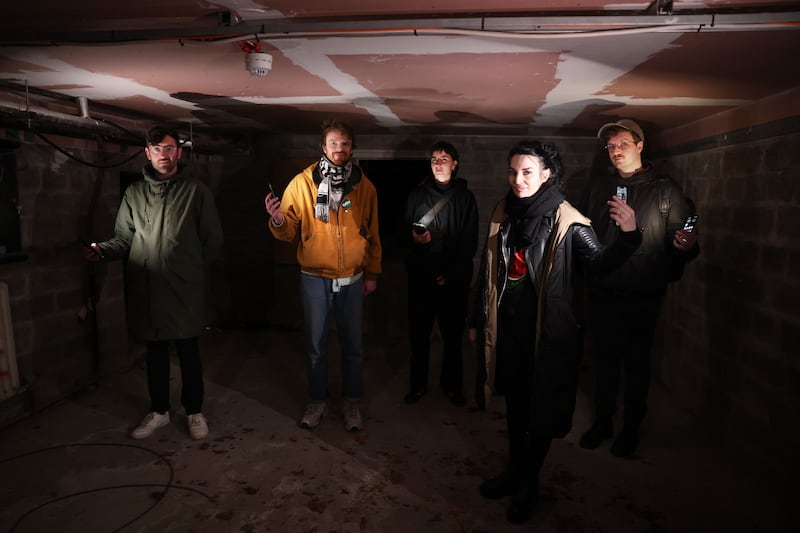
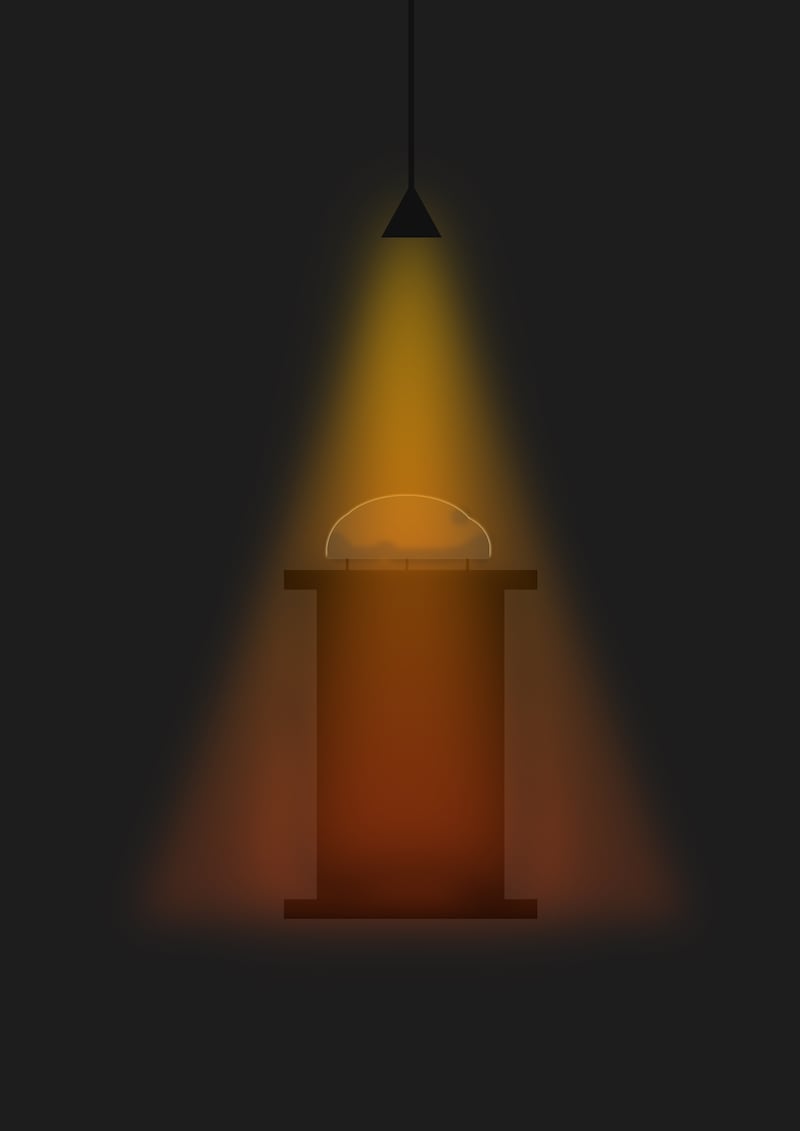
Spending time at the National Archives and the Military Archives, Guinan describes a trove of documentation debating everything from the location of the facility to who should go and whether they should have headed notepaper. Rather than being a retreat for the ruling elite, the national control centre was instead envisaged as a safe place for members of the war cabinet, the commander-in-chief of the Defence Forces, the national controller of Civil Defence and a team to broadcast updates to the nation.
A supply of tinned food was laid in and was, apparently, still there until recently. A memo marked Secret and dated September 29th, 1961, stated that work should begin immediately and that “if the implementation of the Crash Plan became necessary at any stage, the necessary improvisation would have to be effected”. It was assumed that emergency measures would need to be in place for a year.
So, given that it’s more a basement than a bunker, and not even quite as underground as all that, what is it that makes the idea of a not-so-secret fallout facility in the heart of Athlone so compelling? “It’s hard to look away from the end of the world,” says Ian Kenneally, aptly capturing the mood. A historian and producer with Pegasus Media, and creator of The History Show on RTÉ Radio 1, Kenneally is working on panels detailing the background to the bunker for the exhibition. For these he is also drawing on his own History Show research for a programme originally broadcast on September 10th last year.
As I speak with Kenneally, Guinan and some of the other artists involved, I realise there’s an odd sort of humour around our viewing, and around the project. Part of this comes from the way we tend to use levity as a survival response to unimaginable horror – something that is worth remembering in the face of cancel culture.
The bunker’s genesis came in a 250-page document from 1958, says Kenneally. Prosaically titled the Report of the Working Party on Certain Aspects of Civil Defence, “it game-played a nuclear strike over Dublin. It’s an appalling document, because it said that even if the government had time to evacuate half the city, you’re talking about over 100,000 people dead, instantly.” Faced with that, you dig your own fallout shelter, send iodine tablets to everyone in the phone book, or perhaps crack inappropriate jokes.
A 55-page Civil Defence booklet, Bás Beatha (Death of Life), was published in 1965 to provide guidance. Yellow flags were to be hung along roads to indicate the final fallout warning. Refuge rooms at home could be fortified with wardrobes, while a family member should be designated to care for livestock. The apparent smallness of such plans against the vastness of apocalypse is not just an Irish thing. In 1982 a 300-page United States Postal Service plan for continuity of service after a nuclear war was ridiculed for including the printing of change-of-address labels for every post office. “What good will that do?” Edward J Markey, a Democratic congressman from Massachusetts, was reported by the New York Times as saying. “There will be no addresses, no streets, no blocks, no houses.”
So how come Ireland’s “bunker” came to be all but forgotten? Guinan says that in 1984 it was noted that “the interdepartmental committee has not met since 1972” and it was agreed that a combination of industrial action and “events in, and relating to, Northern Ireland had directed attention away from a nuclear-war situation to more immediate matters”. Then, Kenneally continues, “in 1991, when the Soviet Union collapses, it’s like we’ve entered into a new world, and we don’t need to worry any more”.
The whole industry is about a polite front. There’s this pretence that it’s very respectable, but the real shock is weapons being presented as commodity material
— Artist Jill Gibbon on the arms trade
Maybe we do: in the early 1990s the US government tasked teams of experts to come up with a method to communicate the danger of lands poisoned by nuclear fallout across thousands of years. Recognising that our written languages would become impenetrable to future beings after a silence of approximately two millenniums, they asked for symbolic alternatives. The Marker Project, by the architects Michael Brill and Safdar Abidi, suggested a landscape of thorns: a tangled network of huge shards and spikes. Aideen Barry’s Oblivion, from 2021, draws on this by creating a field of 15m thorns on chemically poisoned land near her own home in Tipperary. Guinan has selected elements of this project to be shown at Luan, including still images and prints from her original film, which explores further to link ideas of art, culture and environmental life, all on the brink of collapse under our systems of capitalism and colonialism.
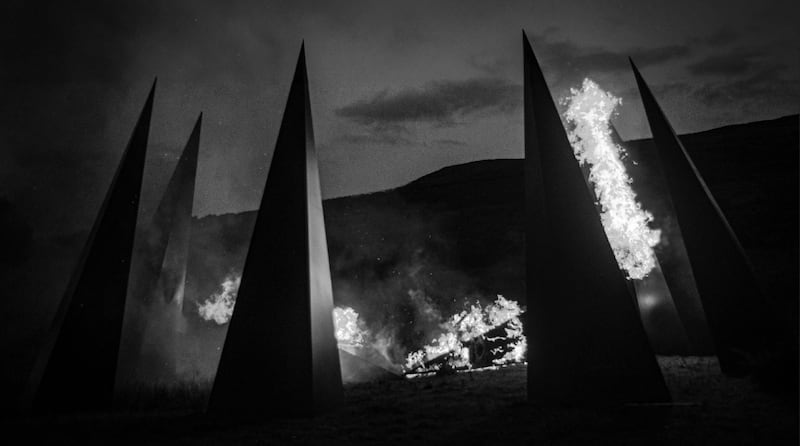

Any Action Deemed Necessary, by Frank Sweeney and Tom O’Dea, draws on the pair’s researches into 55 years of Irish foreign-policy decisions, its name based on a refrain in government communications. Including a classic red phone, their installation invites you to respond to some of the choices facing those involved in government throughout the history of the State, while presenting the evolution of alternative histories, such as what might have happened had the Republic aligned with Nato. “How does a small nation like Ireland exist in the world in relation to bigger nations?” asks O’Dea. “It’s a question that a lot of countries coming out of colonialism are thinking about.”
Léann Herlihy shows work from a series of projects, which also highlight the macho nature of survival culture. “It’s survival as a learning process,” they say. “I came to the idea of survival from a different realm: who’s allowed to be there, who is allowed to occupy these spaces?” Orla Punch imagines a vernacular architecture for the planet Mars, while Christopher Steenson installs a broadcast from cold-war-era radios. Guinan herself is creating a tactile work that she says will pulse with the same beat as the earth. A rock will be adjusted to meet contemporary climate data every time it is exhibited – until it becomes unsafe to touch.
While some of the works in Apocalypse Anxieties deal with climate change, at the heart of it all is the lurking presence of the nuclear bomb. Alfred Nobel created the prizes that bear his name to leave behind a better legacy than the dynamite he had invented; J Robert Oppenheimer was more ambivalent about his role as “father of the atomic bomb”. The fact remains that the huge global arms industry enables and fuels war. Many of the world’s largest economies, including the US, UK, Russia and France, are heavily weighted towards arms manufacture and trade, and with global military expenditure valued at more than $2 trillion (€1.866 trillion) a year, the arms trade is a powerful but secretive interest voice in world politics.
Since 2007 the UK artist Jill Gibbon has been going to arms fairs, disguised variously as a war artist, security consultant and, in suit and fake pearls, as a potential buyer. Covertly sketching this hidden world of string quartets and Scud missiles, champagne and shrapnel, she also collects the incidental gifts offered by the dealers: “wittily” branded sweets, stress balls shaped like grenades, and desktop fighter jets.

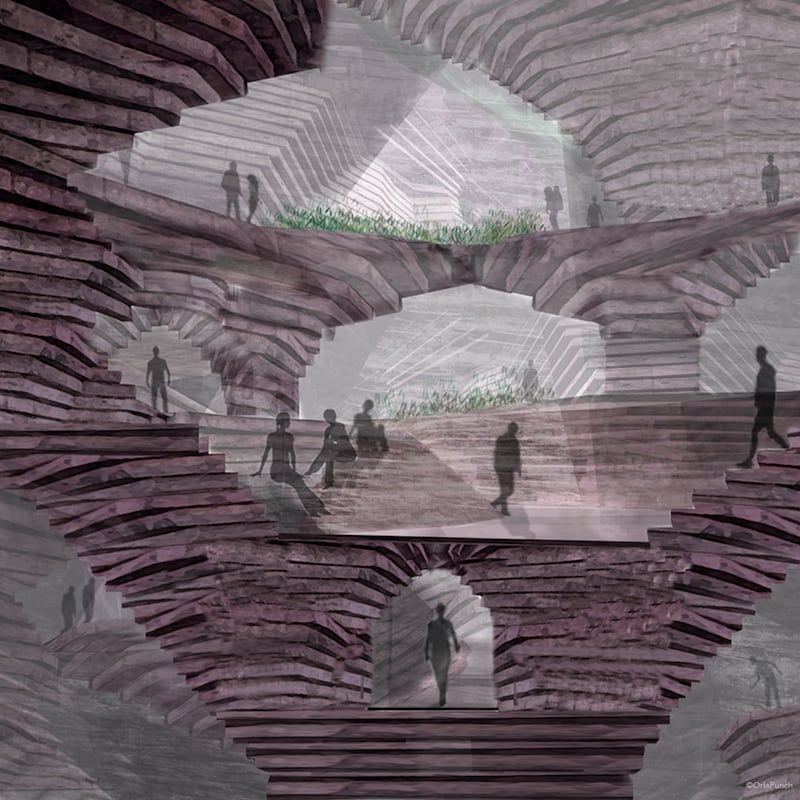
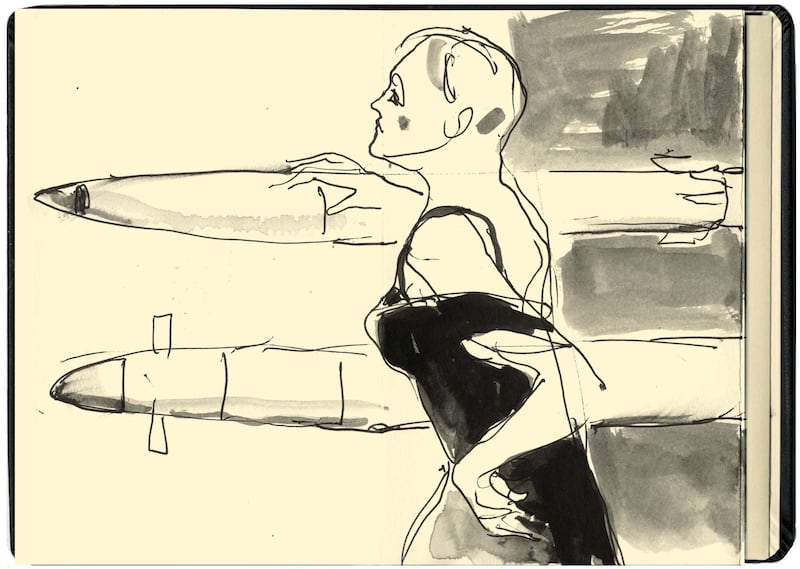
Scheduled to feature in What Do We Want? alongside Eoin MacLochlainn, Tom Molloy and Gail Ritchie, at the Olivier Cornet Gallery in Dublin, Gibbon’s original sketchbook and eight “gifts” were refused entry to Ireland by Customs. Instead, the gallery is showing a slide show and photographs of the work. “I don’t know why they were returned,” Gibbon, who is looking into the matter, says. She describes the atmosphere of the arms fairs themselves.
“The most recent one I visited was DSEI in London in September [2023]. It was frenetic, because of the wars in Yemen and Ukraine. Gaza hadn’t actually started. There is a lot of luxury and glamour,” she says, “and it’s a very, very unnerving juxtaposition. There is lavish food and complimentary wine, mixed up with weaponry.” She describes the beautiful young men and women manning the front desks. “They’re trained to be a polite front. The whole industry is about a polite front. There’s this pretence that it’s very respectable, but the real shock is weapons being presented as commodity material. It’s called the defence industry,” she says. “But weapons are being sold to regimes where they are used on children.”
Art may not stop the apocalypse, but it can open our eyes to what is out there, hiding in plain sight.
Apocalypse Anxieties, including the work of Aideen Barry, Kerry Guinan, Léann Herlihy, Orla Punch, Christopher Steenson, Frank Sweeney and Tom O’Dea, is at Luan Gallery, Athlone, Co Westmeath, until Thursday, June 27th. What Do We Want? continues at the Olivier Cornet Gallery, Dublin, until Friday, May 31st











